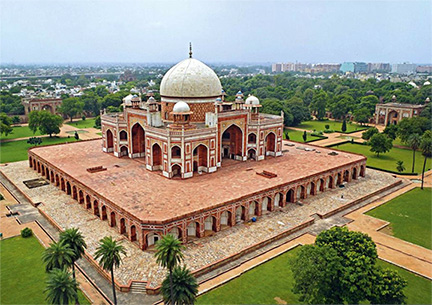Indian Heritage & Culture
Humayun's Tomb: Mughal Architecture
- 16 Jun 2021
- 4 min read
Why in News
Recently, the Archaeological Survey of India (ASI) notified that all centrally protected monuments, sites, and museums across the country including the Humayun’s Tomb will reopen for visitors from 16th June 2021.
- Humayun's tomb in Delhi is a fine specimen of the great Mughal architecture.
- ASI, under the Ministry of Culture, is the premier organization for the archaeological research and protection of the cultural heritage of the nation.
Key Points
- Humayun’s Tomb:

- About:
- This tomb, built in 1570, is of particular cultural significance as it was the first garden-tomb on the Indian subcontinent.
- It inspired several major architectural innovations, culminating in the construction of the Taj Mahal.
- It was built under the patronage of Humayun’s son, the great Emperor Akbar.
- It is also called the ‘dormitory of the Mughals’ as in the cells are buried over 150 Mughal family members.
- It is an example of the charbagh (a four quadrant garden with the four rivers of Quranic paradise represented), with pools joined by channels.
- The United Nations Educational Scientific and Cultural Organisation (UNESCO) recognized it as a World Heritage Site in 1993.
- This tomb, built in 1570, is of particular cultural significance as it was the first garden-tomb on the Indian subcontinent.
- About:
- Mughal Architecture:
- About:
- This is a building style that flourished in northern and central India under the patronage of the Mughal emperors from the mid-16th to the late 17th century.
- The Mughal period marked a striking revival of Islamic architecture in northern India. Under the patronage of the Mughal emperors, Persian, Indian, and various provincial styles were fused to produce works of unusual quality and refinement.
- It became so widespread especially in north India that these can be seen further in the colonial architecture of Indo-Saracenic style.
- Important Features:
- Mixed Architecture: It was a blend of Indian, Persian, and Turkish architectural style.
- Diversity: Different types of buildings, such as majestic gates (entrances), forts, mausoleums, palaces, mosques, sarais, etc.
- Building material: Mostly, red sandstone and white marble were used.
- Speciality: Specific features such as the Charbagh style of the mausoleums, pronounced bulbous domes, slender turrets at the corners, broad gateways, beautiful calligraphy, arabesque, and geometric patterns on pillars and walls, and palace halls supported on pillars.
- The arches, chhatri, and various styles of domes became hugely popular in the Indo-Islamic architecture and were further developed under the Mughals.
- Some Examples:
- Taj Mahal:
- Built by Shah Jahan between 1632 and 1653, in memory of his wife Mumtaz Mahal.
- UNESCO recognized the Taj Mahal as a World Heritage Site in 1983. It is located in Agra.
- Red Fort:
- Built by Shah Jahan in 1618 when he decided to move the capital from Agra to Delhi. It was the residence of Mughal rulers.
- UNESCO designated it as the World Heritage Site in 2007.
- Jama Masjid:
- Built by Shah Jahan in Delhi. The construction was completed in 1656.
- Badshahi Mosque:
- Built during the reign of Aurangazeb. At the time of completion in 1673, it was the largest mosque in the world. It is located in Lahore, capital of the Pakistani province of Punjab.
- Taj Mahal:
- About:




